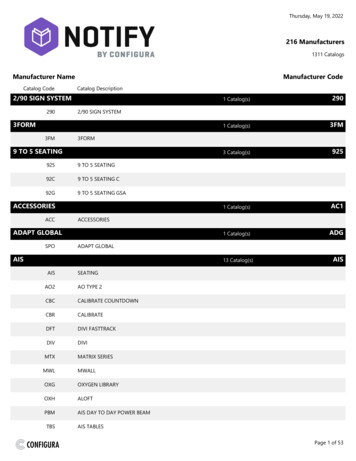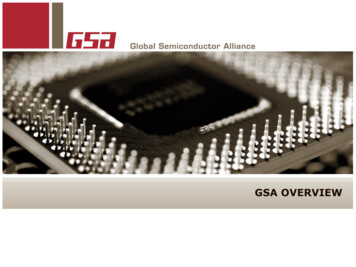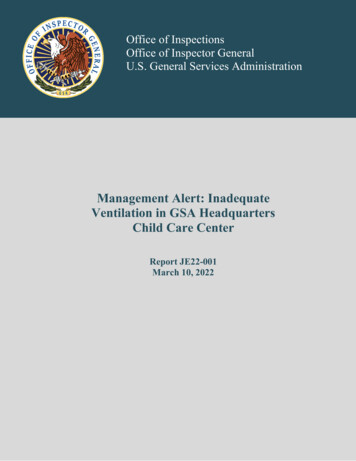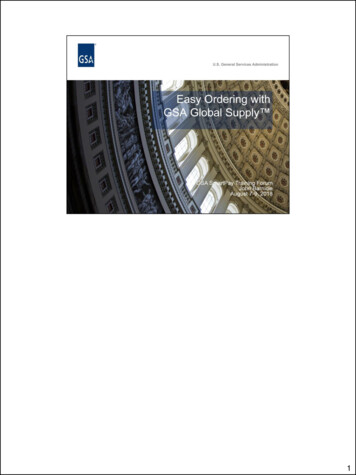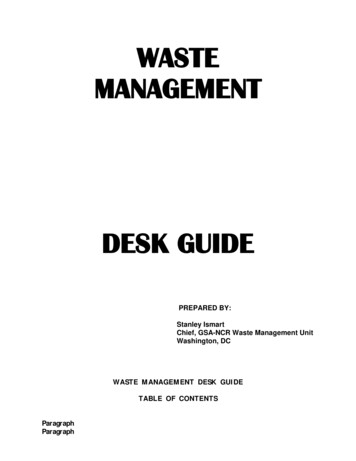
Transcription
WASTEMANAGEMENTDESK GUIDEPREPARED BY:Stanley IsmartChief, GSA-NCR Waste Management UnitWashington, DCWASTE M ANAGEM ENT DESK GUI DETABLE OF CONTENTSParagraphParagraph
TitlesNumbersPART 1. GENERALAn Essential Program. 1Integrated Solid Waste Management. 2Responsibility for Solid Waste Management. 3Objectives of Solid Waste Management. 4Regional Waste Management Program. 5Definitions. 6Solid Waste. 6aRefuse. 6bRubbish. 6cAsh. 6dWhite Goods. 6eSpecial Wastes. 6fGarbage. 6gLoose Trash. 6hDebris. 6I .Reserved. 7 thru 35PART 2. WASTE M ANAGEM ENT SERVI CESStorage. 36Collection Equipment - Custodial. 37Trash and Debris Removal Services. 38Loose Trash Service. 39Closed Container Service. 40Compactor Service. 41Stationary Compactor. 41aSelf Contained Compactor. 41bCompactor Service Fees. 41cBuilding Requirements. 41dCompactor Location. 41eDetermining if A Compactor is Full. 41fSpecial Features to Protect Against Trash.Spillage and Pest Infiltration. 41gCompactor Size Requirements. 41hDebris Service. 42Reserved. 43 thru 73PART 3. PEST I NFESTATI ON AND THE WASTE STREAM I N PUBLI CBUI LDI NGSRefuse and the Necessities of Life.The Pest’s PerspectiveOffice House Keeping.Collection and Removal of Refuse from Work Areas.747576
Deny Access to Refuse Holding Areas. 77Design Them Out - Pest Proof Equipment.78Reserved.79-108PART 4. THE WASTE M ANAGEM ENT CONTRACTContract Procurement.Equipment Features and Restrictions.Inspection of Equipment.Maintenance of Equipment.Rat Proofing Equipment.Service Requirement Changes.Disposal Facility.Environmental Quality Assurances.109110111112113114115116PART 5. I LLUSTRATI ONSWaste Management Trucks.Front End Load Closed Containers.Stationary Compactor.Specifications on Standard Self-Contained Compactors.Clearances for Complete Roll Off Systems.20-30-40 Cubic Yard Open Top Containers.40-50 Cubic Yard Rectangular/Octagonal Compactor Receiver.Approximate Solid Waste Generation Guideline:Commercial Standards.GSA Waste Management Standards: Trash and Debris.GSA Waste Management Standards: Recyclable Materials.Fig. 1Fig. 2Fig. 3Fig. 4Fig. 5Fig. 6Fig. 7Fig. 8Fig. 9Fig.10
SOLID WASTE MANAGEMENTPART 1. GENERAL:1. An Essential Program:The collection and disposal of non-hazardous solid waste from Governmentbuildings is one of the most essential of the Building Services Program areas.The success or failure of waste management activities directly affects theproductivity, health and well being of Government employees.The cost of solid waste disposal services has risen dramatically in recent yearsdue to the closing of municipal landfills and the proliferation of legislationgoverning solid waste disposal practices. These events have dramaticallystrained our ability to fund these programs.2. I ntegrated Solid Waste M anagement: In an effort to address this nation’s “SolidWaste Dilemma”, the Environmental Protection Administration (EPA) suggestsimplementing an Integrated Waste Management plan of action. The first level ofthis plan is “Source Reduction” which is reducing the amount and/or toxicity ofwaste generated. All Government employees can participate in SourceReduction. These efforts can be as simple as photo copying on both sides of apage or as complex as modifying procurement specifications to include specificamounts of recycled materials in the makeup of products purchased by theGovernment.Recycling is the second level of this plan. Recycling is collecting, reprocessing,marketing, and using materials that were once considered trash. Many of thecomponents of our waste stream can be recycled, from metals and plastics toused oil and paper. Source Reduction and Recycling are addressed in the GSApublication, “Federal Recycling Program Desk Guide”.Waste Combustion and landfilling are the last components of EPA’s IntegratedWaste Management Plan. Combustion can be used to reduce the volume of thewaste stream and to recover energy. Landfilling is the only true disposal option.It is a necessary component of waste management, since all managementoptions produce some residue that must be disposed of through landfilling. EPA,State and local Governments are working hard to improve the safety of bothcombustion and landfilling, through new regulatory control, design andoperational practices, training and careful monitoring.3. Responsibility for Solid Waste M anagement:
Disposal of solid waste is normally the responsibility of the agency operating aFederal Building. The responsibility for disposal of solid wastes in leasedbuildings depends upon the lease agreement. In connection with the operationof concession facilities in buildings, waste disposal is the responsibility of theconcessionaire. However, GSA will be responsible for removing solid wastesgenerated by vending stands operated under the provisions of the RandolphSheppard Act.4. Objectives of Solid Waste M anagement:The objectives of solid waste management in GSA operated buildings are asfollows:a. The reduction of the amount of solid wastes produced in GovernmentBuildings.b. The salvage and recycling of as much waste material as possible.c. The disposal of non-recyclable solid waste in ways which will not pollute theenvironment.d. The disposal of solid wastes in the most economical manner in terms ofbuilding operation taking the above factors into consideration.5. Regional Waste M anagement Program:Each region must develop the expertise to address Solid Waste Managementissues. Regional goals must include a commitment to identify and remove allnon-hazardous waste matter from Government property while complying withexisting regulations to insure employee safety and environmental integrity.A Regional Waste Management Program should include the followingobjectives:a. Maintain a data base for all disposal services including the identification of thetype, volume, and location of all wastes and reclaimable matter.b. Coordinate all contracting activities over 25,000 for all waste removalservices.c. Establish a workable materials reclamation program: Recycling will beperformed in all Government-owned or operated buildings when required bylocal or state laws. In the absence of laws, recycling will be performed whenthere are 100 or more employees in a building and there is a market for therecyclable material. Recycling will be undertaken whenever it is deemed tobe in the best interest of the Government, taking into account environmentaland economic factors.
d. Analyze all wastes and waste streams to determine the most efficient, costeffective and safe method of removal.e. Provide training to field personnel on the available waste removal services.f. Work closely with the Safety and Environmental Management Division toidentify and safely remove hazardous wastes or waste related conditionswhich may result in an accident or health threat.g. Assist the Regional Integrated Pest Management (IPM) Program in its effortsto correct any waste related conditions conducive to pest infestation.h. Maintain a technical reference library of waste removal related literature andequipment specifications.I. Maintain an awareness of all local, state and Federal waste disposal laws andregulations.j. Serve as the Region’s Waste Management focal point to offer any technicalservices required to establish the most efficient and cost effective trash anddebris removal service possible.k. Serve as the Region’s liaison with local, state and Federal agencies dealingwith waste management problems including the preparation of allnonhazardous waste management related correspondence.l.Serve as the Region’s liaison with waste management professionalorganizations and contractors.m. Prepare and monitor the Regional Yearly Budget for Waste RemovalServices and Recycling activities.6. Definitions:The following definitions of solid waste and its components apply throughout this textand represent the most widespread meaning of the terms.A. Solid Waste:Solid Waste refers to the useless, unwanted or discarded materials resulting froman agency’s normal activities. Wastes may be solids, liquids, or gases. Onlysolid wastes are classed as refuse. Liquid wastes are mainly sewage andindustrial waste waters, including both dissolved and suspended matter.Atmospheric wastes consist of particulate matter such as dust, smoke, fumes andgases. The physical state of wastes may change in conveyance or treatment.Dewatered sludge from waste water treatment plants may become solid wastes;garbage may be ground and discharged into sewers, becoming water-bornewastes; and fly ash may be removed from stack discharges and disposed of assolid or as water-borne wastes.
B. Refuse:Refuse comprises all of the solid wastes of the community which may includesome semisolids such as pastes, slurries, and sludges which cannot be treated ina conventional waste water treatment plant.C. Rubbish:Rubbish consists of combustible and noncombustible solid waste materials(excluding garbage) from households, stores, offices and institutions.Combustible rubbish is composed of miscellaneous burnable materials. Theorganic components of rubbish are paper, rags, cartons, boxes, wood, bedding,rubber, leather, grass, leaves and yard trimmings, plus certain inorganic materialssuch as plastics. Noncombustible rubbish consists of miscellaneous solid wastematerials that will not burn at ordinary incinerator operating temperatures (1300 Fto 2000 F). It consists mostly of the inorganic component of rubbish such as tincans, metals, dirt, ceramics, and glass. Although noncombustible rubbish ischemically and physically stable, it is esthetically objectionable and may collectmosquito breeding water or harbor vermin if carelessly stored.D. Ash:Ash is the residue from burning wood, coal, coke, and other combustible material.Ash usually consists of a mixture of fine powdery residue, cinders (except thoseproduced in large quantities at steam generating plants), clinkers, and smallportions of unburned or partially burned fuel. Metal, glass, and other combustiblematerials are sometimes found in ash. The residue from central or municipalincinerators should be classified as industrial refuse rather than ash.E. White Goods:White goods is a class of bulky wastes which includes major appliances such aswashers, dryers and refrigerator units. Special care must be taken with theseitems due to the presence of contaminating materials including freon gas,asbestos and PCB’s.F. Special Wastes:Special wastes are hazardous by reason of their pathological, explosive,radioactive, caustic, or toxic nature. They require careful specialized handling torender them safe for an adequate decay period. These wastes will beresponsible disposed of by the institution generating them.G. Garbage:Garbage is the animal and vegetable waste resulting from handling, preparing,cooking, and serving foods. In Federal Buildings, it originates primarily incafeterias, snack bars and employee lunches. Garbage is composed largely of
decomposable organic matter and its natural moisture content. Garbage normallyincludes only a small amount of free liquids. Collection vehicles must be watertight, however, to prevent these liquids from leaking into the storage area orstreet. Garbage decomposes rapidly, particularly in warm weather, and mayproduce disagreeable odors. When carelessly stored, it often becomes a sourceof food for rats and other vermin and a breeding place for flies.H. Loose Trash:Loose trash consists of office rubbish bagged in plastic bags, gathered in mobilecarts, or stored in trash rooms. Office refuse is predominantly paper materials55-85%, on average 71%. Lunch and food wrappings, cans and glass, metalfasteners, plastic and some fabric materials make up the remainder of the officetrash waste stream. The terms trash and rubbish are used interchangeably in thismanual.I. Debris:Debris includes but is not limited to plaster, wall board, stone, ceramic tile, oldfluorescent tubes and contaminated wood, etc. Contaminated wood includesscrap lumber, crates, wooden boxes, skids, etc.7 thru 35. RESERVEDPART 2. WASTE M ANAGEM ENT SERVI CES:Waste Management Services begin with the removal of trash from the work areaby the custodial crew. The trash is then transported to a holding area which mayinclude a trash room, container, or a compactor.36. Storage of Office Trash:a. Trash should be picked up on a regular basis. Cleanliness is key toeliminating odors and not attracting vermin.b. Each custodial contract should include provisions for routine trash cancleaning, including the removal of all encrustation caused by spillage, liquid,solid food and other materials.c. Each trash can should be lined with a plastic bag and the plastic bag shouldbe replaced on an as required basis. As a minimum, plastic bag liners mustbe 1.00 mils in thickness.d. Trash cans should be emptied in the evening or at least after the employeeseat lunch. This will prevent lunch discards, including food and beveragecontainers, from being stored in the waste receptacles over night, the most
active time for pest infestation.e. Trash containers, with plastic liners and tight fitting lids, dedicated to thestorage of garbage, should be provided in each office area. Thesecontainers must be washable and should be distributed at the rage of one perevery 10 to 15 employees. These garbage containers must be emptied dailyand washed on a regular basis.37. Collection Equipment - Custodiala. Drums and Carts:The types and construction of custodial trash collection equipment varies withindividual requirements and preferences. The most common types ofcollection equipment include the mobile 55 gallon drum used to collect trashat each work station and the mobile 3/4 cubic yard to 2 cubic yard utility cartused as a collection consolidation container for an entire sector of a building.All containers must be constructed of non-porous, leakproof materials suchas rubber, metal or plastic, including fiberglass. These materials will allow forthorough sanitizing and will prevent spillage. Tight fitting lids should bemandatory when storing garbage. Provisions for the routine cleaning andsanitizing of custodial trash collection equipment must be part of anycustodial contract.b. Trash Chutes:Trash chutes are not common in Government buildings but are an expedientmethod of trash consolidation if properly constructed and used. Chutes mustbe made of noncombustible materials with a fire suppression systeminstalled.They must be designed with an access to their interior to allow for periodiccleaning. This cleaning must be accomplished by a contractor withspecialized equipment designed to service trash chutes. Special tenanttraining must be available to educate people as to what may be disposed ofin the trash chutes and how it should be packaged.c. Storage and Removal of Refuse from the Building:Containers used for the removal of office trash should be constructed of nonporous materials such as plastic, fiberglass, or metal to allow for thoroughsanitizing and to prevent spillage. Tight fitting lids should be mandatory whenstoring garbage. Provisions for the routine cleaning and sanitizing ofcustodial trash collection equipment must be part of any custodial contract.
38. Trash and Debris Removal Service:There are basically 4 types of trash and debris removal services typically used inFederal buildings. They area:a.b.c.d.Loose Trash ServiceClosed Container ServiceCompactor ServiceDebris Service39. Loose Trash Service:Loose trash service uses a rear end loader packer truck with a driver and oneor more helpers.a. Least Cost Effective M ethod: This is the most labor intensive and least costeffective method of the trash removal services because trash is manuallypicked up and loaded into the rear hopper of the truck. The rear end loadertruck will then compact the trash at a compaction ratio of up to 6 to 1. Thesetrucks typically range in size from 25 to 31 cubic yards so their potentialvolume may be as much as 180 cubic yards of trash depending upon the sizeand condition of the truck and what is being loaded. (See Figure 1).b. Choosing Loose Trash/Rear Packer Service:Rear Packer Service is used when access to a building is restricted byclearance, traffic congestion problems or their is no room for a container orcompactor. Typically, a rear end loader or packer truck requires 11.5 to 13feet clearance.c. Characteristics of Rear End Packer Service:The packer truck servicing a building is most likely following a scheduledroute. The driver will stop at several locations to load trash and will dump itsload after the truck is full. The customer is either charged by the cubic yardor a monthly flat rate based on historical data and experience. Fees includethe use of the truck, the driver’s and helpers time, all hauling or transfer feesand the dumping or tipping fee.d. Loose Trash Storage:Loose trash is usually stored in a trash holding room located on the ground orsub-level of a building. The storage area should preferably be located near aloading dock or ground level exit, convenient to the freight elevators. Wherespace is not available, trash may be stored loose in custodial carts on theloading dock, or other designated areas. Daily removal is recommended withno overnight storage.40. Closed Container Service:
Detachable closed container service includes the furnishing of closed typecontainers, their removal and replacement, their dumping into trucks by the use ofvehicles equipped with hoisting equipment, and the disposal of trash. Trucks arescheduled on a route and the charge is by the “pull”. Each time a closed containeris emptied, a fee is charged based on the volume of the container(s) and thefrequency of service.a. Closed Container:Closed containers are of a type to facilitate loading by personnel from theside or top from a normal standing position. They are of a type affordingmechanical handling and hoisting for emptying into a front end loader truckfor transport to the place of disposal. The closed containers must beconstructed to prevent the spillage of liquids or scattering of trash.Closed containers come in sizes ranging from 2 cubic yards up to 10 cubicyards. The size of the closed container is dictated by the volume of trashbeing generated. (See Figure 2)b. Front End Loader Trucks:These trucks are equipped with a mechanical front end loading device whichlifts the closed container and empties it into the top of the truck’s body.These trucks range in size from 30 to 44 cubic yards and compact the trashup to a 6 to 1 ratio. With their mechanical arms extended, the heightrequirement to unload a container is approximately 23 feet. Normal heightclearance is 14 feet. The average truck requires approximately 45 feet tosafely approach and load a closed container. (See Figure 1)c. Closed Container Service Fees:Each time a closed container is emptied or “pulled”, a fee is charged basedon the volume of the closed container and the frequency of service. Chargesinclude:(1)(2)(3)(4)equipment rentaltruck usagehauling or transfer feedumping or tipping fee41. Compactor Service:This efficient trash collection service uses a roll off type truck. Trash is compactedin a compactor and removed to a materials recovery facility, transfer station, landfillor incinerator, emptied, and returned to its original location.a. Stationary Compactor:
A stationary compactor has its charge unit separate from its container. Thetwo are held together by mechanical means. This equipment can compactmaterials up to a 3 to 1 ratio depending on the condition of the equipmentand the types of materials being processed. Sizes generally range from 10 to50 cubic yards. Because the charge unit is separate from the container, gapsof from 1 to 6 inches are not uncommon. Leaks and spillage may also occurduring the removal operation. The container may come in either arectangular or octagon configuration. The octagon shape is preferredbecause studies indicate that it compacts material up to 15% more efficiently.(See Figure 3)b. Self Contained Compactor:The self-contained compactor has its charge unit as an integral part of thecontainer. This equipment has the ability to compact material up to a 4 to 1ratio. Capacity ranges from 10 cubic yards to 35 cubic yards. Again, theoctagon configuration is preferred due to its greater compacting efficiency.Because the charge mechanism and container are one unit, rodentinfiltration, leakage and spillage of trash during the removal operation isminimized. (See Figure 4)c. Compactor Service Fees:Compactor service may be paid by the removal. Charges included:(1)(2)(3)(4)equipment rental feeuse of roll off truck and driverhauling or transfer feedumping or tipping feeIt is recommended that the actual dumping fee be paid separate from thetransfer fee using the disposal facility’s certified weight tickets asdocumentation. This policy will insure fairness to both the Government andthe contractor. Also, it’s recommended that the equipment rental fee be paidseparate from the hauling or transfer fee to insure contractors are reimbursedfor their equipment costs. This will facilitate changes to scheduled pulls totake advantage of source reduction and recycling efforts.d. Building Requirements:(1) Access:The minimum clearance required by a roll-off trash truck servicing a selfcontained compactor is 17’- 6”. The minimum clearance required byrectangular containers including the truck is 23’ 10”, while an octagoncontainer including the truck requires 23’ - 3”. With special equipment,this height restriction may be reduced to 11 feet. The raised standardtruck lift hoist is 22’ - 0” in height. (See Figure 5)
(2) Pad Requirements:The concrete pad supporting the compactor must be 10’ - 0” wide and thelength 5’ - 0” greater than the combined length of the compactor andcontainer. It should be made of a minimum 3000 PSI concrete, steelreinforced and 6” thick.(3) Electrical Service Requirements:All compactors require some type of electrical service. The electricalrequirements will depend on the size and capacity of the equipment beinginstalled. A typical 20-30 cubic yard compactor will require service for anelectric motor 3/60/230-460, 10 hp, with electrical control voltage of 120VAC.e. Compactor Location:The compactor is normally placed on a paved area with unrestricted accessto the street. Its location is usually beside a loading dock which has accessto freight elevators. Roll-off trucks servicing compactors require approximately 65 feet unrestricted operating room to properly load and unload thecompactor.f. Determining if a Compactor is Full:A compactor does not start compacting until it is full. Banging the side of thecompactor’s container does not tell very much to the untrained ear. Thecharge unit ram only enters the lower half of the container, 10’ - 15” inches.The compactor repeatedly builds up a column of trash which eventuallybreaks up, then continues the loading process until the container is full. Nowthe real compaction process begins. Compaction should continue until apressure of about 1800 to 1850 PSI is built up in the ram head hydrauliclines. Designed maximum pressure is about 2000 PSI. At an unimpededpressure (no spikes) of 1850, the compactor is considered full or “packedout”. Compactors failing to accept material at less pressure should bechecked for mechanical or hydraulic problems or governor readjustment.Weight may also be used to determine if a compactor is full. However, theweights of the materials being compacted vary making this method lessaccurate. Loose office trash weighs approximately 100 pounds per cubicyard. If a self-contained compactor compacts at a 4 to 1 ratio, each cubicyard of trash compact would weigh about 400 pounds. Therefore, knowingthe designed capacity of your compactor will give an approximate weight tocheck against the landfill’s computerized weight slips.
Compactor Volume in Cubic Yardsin Tons101520253035Approximate Weight2.003.004.005.006.007.00g. Special Features to Protect Against Trash Spillage and Pest Infiltration:(1) The multicycle timer with ram stop forward, positions the charge ram inthe extended positions to seal the opening to the charge box. This willhelp protect against rodent infestation and spillage of trash due to thewind. Unfortunately, there will be a 5 or 6 inch opening near the breakerbar designed for pressure release during the compaction cycle.(2) Doghouse - This is an enclosure built on top the charge unit which isused to restrict the use of the compactor, protect against trash spillageand further hinder the infiltration of pests. This is the best all aroundprotection against spillage and unauthorized infiltration.(3) Ozone Generator - Ozone gas (0 ) generating equipment charges thecompactor container with ozone which inhibits the growth of bacteria anddecreases organic decomposition odors. This system also displacesoxygen in the container so that foraging rodents cannot use the interior ofthe compactor as a shelter. Proper ventilation is required.h. Compactor Size Requirements:Data developed by the National Capital Region Waste Management Unitindicates that a Government building will generate approximately 2 1/2 - 3 lbs.of trash per employee per day with about 3/4-1 lbs. of this waste streambeing removed as recyclables.The commercial hauling industry offers the following formula to determinetrash volume generation in commercial office buildings.1 cubic yd. per 10,000 gross sq. ft. per day.These formulas are for estimating purposes only. A survey should beconducted to determine the type and actual volume of waste generated.The goal is to place the largest possible piece of tra
Objectives of Solid Waste Management: The objectives of solid waste management in GSA operated buildings are as follows: a. The reduction of the amount of solid wastes produced in Government Buildings. b. The salvage and recycling of as much waste material as possible. c. The disposal of non-recyclable solid waste in ways which will not pollute the
